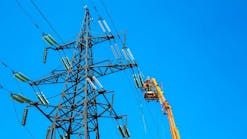In 2008, central Danish politicians established new guidelines for the expansion and undergrounding of the overhead transmission system in Denmark. As the country’s transmission system operator, Energinet.dk was required to replace some sections of the existing 400-kV overhead lines with underground cables within 10 years. This plan was later reviewed, resulting in some undergrounding projects being deferred until after 2020.
The new guidelines are particularly applicable to overhead transmission lines in areas with a beautiful environment of national interest and in populated areas. From 2008-2016, Energinet.dk undergrounded three sections of the existing 400-kV overhead lines.
The Lillebaelt Project
In central Denmark, between the towns of Middelfart-on-Funen and Fredericia in Jutland, two separate 400-kV overhead lines cross the Lillebaelt (Little Belt), a deer park, a residential area, a marine area and a golf course. These two overhead lines were prioritized as the first existing 400-kV lines to be undergrounded in accordance with the new guidelines.
The two overhead lines connect the Landerupgaard substation in Jutland with the Kingstrup and Fraugde-on-Funen substations. At 33 km and 73 km (20 miles and 45 miles) long, the overhead lines are the main connections to the island of Funen, which has a population of some 150,000 inhabitants including the city of Odense. From Funen, there is a high-voltage direct-current (HVDC) connection to the island of Zealand, which is in the eastern part of Denmark where the capital city of Copenhagen is located.
Design Considerations
An existing single 150-kV submarine cable has insufficient load-transfer capacity to supply this area, and an HVDC connection is dependent on the short-circuit power level on Funen. Therefore, the existing 400-kV AC lines are very important for this area, which merits a high reliability supply.
The load-transfer capacities of the existing 400 kV overhead lines were 1650 MW and 1100 MW. Using a single underground cable circuit for each overhead line would limit the transfer capacity to about 600 MW for each line. Before reaching a final decision on the solution, the need for more than 600 MW of load-transfer capacity was considered. The studies undertaken confirmed that 600 MW of load-transfer capacity was adequate.
The cable route selected had to cross Lillebaelt, a seawater channel with a strong current and steep slopes close to the shoreline. Lillebaelt is a busy waterway, so there was a potential for damage to be caused to the submarine cables by emergency dropping of anchors or other activity. The seabed of the Lillebaelt is hard clay, which is difficult to excavate. Therefore, it was a challenging task to protect the submarine cables.
Submarine Cable Design
The choice of submarine cables was difficult to make as the maximum voltage for three-core cables in the market was 245 kV (Um = maximum voltage for equipment). The 245-kV three-core cable systems had been used for the connection of offshore wind farms, but cables for higher voltages had been based only on the use of single-core cables. Therefore, Energinet.dk faced a problem as no manufacturer had produced a 400-kV (Um = 420 kV) three-core submarine cable.
Submarine cables must satisfy a demanding specification in terms of the radial and longitudinal forces experienced on the seabed and during installation. Hence, the overall design of the cable required optimization of the mechanical characteristics and capital cost.
Therefore, Energinet.dk invited tenders for a range of different solutions. The tender gave cable manufacturers the freedom to offer 400-kV single-core or 400-kV three-core submarine cables. From an economical viewpoint, the three-core cables were the right solution, provided the specification satisfied all technical standards and operational risks. Although the unproven 400-kV three-core submarine cable joints were a concern, they were ordered from ABB for installation during the summer of 2013.
The 400-kV three-core submarine cable was designed with 1400-sq-mm (2.17-sq-inch) aluminum conductors and the 400-kV AC single-core underground cables with 1200-sq-mm (1.86-sq-inch) aluminum conductors. Aluminum was selected over copper for the conductors as a way to minimize the project cost. The cable insulation was cross-linked polyethylene (XLPE), which had been used with long-term success in cables designed for 400-kV operation.
The radial water barrier of the submarine cable used a traditional lead alloy sheath protected by a semiconducting polyethylene sheath. The underground cables had a radial water barrier of aluminum laminate, and a semiconducting swelling tape was used as a longitudinal water barrier between the insulation screen and sheath.
The complete assembly of the submarine cable included three cable cores, three polymeric fillers and one loose tube for a fiber-optic cable, held together by semiconducting tapes. Finally, to reduce the armor losses, the cable armor was made of stainless-steel wires instead of galvanized steel wires.
Cable Route and Installation
The offshore cable route is 7.5 km (4.66 miles) in length including a 2-km (1.24-mile) crossing of the belt, which had a depth of up to 50 m (164 ft) and a strong current. The remainder of the crossing was routed in the narrow strait of Faenoe Sund, which has shallow water. The cables were installed in the Lillebaelt area with a separation of about 300 m to 500 m (984 ft to 1640 ft) to reduce the probability of damage to both cables.
Because of the composition of the seabed, it was not possible to use water jetting in some parts of the subsea route to bury the cables. Therefore, JD-Contractor A/S installed the cables at a target depth of 1 m to 1.5 m (3.3 ft to 4.9 ft) using an excavator on a barge in the shallow water. In the deep water, it was necessary to lay the cables on the seabed — burying them using water jetting — and in short sections to protect the cables by rocks.
ABB supervised the underground cable installation and also was responsible for the joints and terminations. Arkil A/S performed the site work, including all trenching, drilling and cable pulling. The onshore cable route included road crossings, sloping ground within a wooded area, a golf course and farmland. The road crossings were constructed with horizontal directional drilling (HDD) equipment, with each 400-kV single-core cable installed in a high-density polyethylene duct. Following the cable installation, all the ducts were filled with bentonite to maintain a stable thermal resistance.
When crossing farmland, the 400-kV underground cables were installed in open trenches excavated the day before installation. Prior to pulling in the cables, the trench bottom was covered with 100 mm (4 inches) of sand. Following the cable installation, the trench was backfilled with a 200-mm (8-inch)-thick layer of sand with a good thermal resistivity and the remaining excavated soil. The distance between the two underground cable circuits was 6 m (19.7 ft), with the single-core cables laid in flat formation and 0.4 m (1.3 ft) of separation.
The 400-kV underground cables were installed close to the existing 400-kV overhead lines, which were still in service. If the overhead lines suffered a short-circuit failure, it could expose workers to high-induced voltages. Therefore, severe restrictions were imposed on the working conditions in such areas.
The screen of the single-core underground cables was cross-bonded in two positions on the Funen section, while it was possible to use single-point bonding on the Jutland side because the cable route length was only 1 km (0.62 mile). Cross-bonding and single-point bonding were used to maximize the current rating of the cables.
Reactive Compensation
Reactive power compensation was necessary because approximately 10 MVAR is produced for each kilometer circuit length of the 400-kV cables. Two 65-MVAR reactors were installed in the 400-kV Landerupgaard substation about 8 km (5 miles) from the cable terminations in Jutland. The reactors were connected directly to the two 400-kV overhead lines in the substation.
If the directly connected reactors compensate more than 50% of the total reactive power produced by the circuit (cable plus overhead line), then zero-miss is a concern. In case of a line failure during energization, it would not be possible to break the current for some seconds because of a DC component in the current through the circuit breaker (that is, no current zero-crossing in the breaker current). To avoid this situation, the directly connected reactors only compensate about 50% of the reactive power produced by the circuit. A third reactor, a variable reactor rated at 50 MVAR to 100 MVAR, has been installed in a separate bay in the substation to ensure full compensation of the reactive power.
On-Site Testing
The 400-kV underground and submarine cables were tested in accordance with the relevant International Electrotechnical Commission (IEC) standards and International Council on Large Electric Systems (CIGRE) recommendations. There are no IEC standards for this voltage level regarding the mechanical testing of submarine cables, so the CIGRE recommendations were applied.
Following installation, the commissioning tests on the cable installation included a high-voltage test at 1.7 U0 for one hour (U0 = 220 kV). The bonding systems of the underground cables also were tested after the installation, applying 10 kV on the sheath.
System Protection
Each of the 400-kV cable sections form part of an existing transmission circuit where the overhead line section was protected by distance and differential protection relays. This arrangement remains the same, so if a phase-to-earth failure occurs in one of the cable sections, the section will be reclosed automatically after about 900 msec.
Transition Compounds
To satisfy the environmental requirements of minimizing the visual impact of the two transition compounds, Energinet.dk adopted nontraditional design features. On Funen, the transition from the 400-kV overhead lines to the 400-kV underground cables is located in a position screened by a hilly terrain, so a simple open and compact transition compound was constructed. On the Jutland side of the Lillebaelt, the transition compound is located in an industrial area and clearly visible to the public. Therefore, the utility decided to construct a highly visible open compound, showing the anchor blocks used to terminate the overhead lines.
Experience to Date
In November and December 2013, the two 400-kV underground and submarine cable circuits were commissioned to replace the 400-kV transmission lines being dismantled. The two cable circuits have been in service for almost three years without any failures.
This project demonstrates the merits of 400-kV three-core submarine cables. The installation is much simpler because three-core cables require a lot less space, but the disadvantage is the circuit load-transfer capability is less than that of an equivalent single-core cable installation.
Christian Jensen holds a master’s degree from the Technical University of Denmark. He started his career with a regional transmission utility working on 60-kV and 150-kV substations, overhead lines and underground cables. In 2003, Jensen joined the Danish transmission system operator, Energinet.dk, as a cable expert and currently serves as the chief project manager. He has convened two CIGRE working groups on underground and submarine cables, was a member of CIGRE Study Committee B1 (insulated cables) from 2004 to 2010 and has been a member of the Strategic Advisory Group since 2011.











